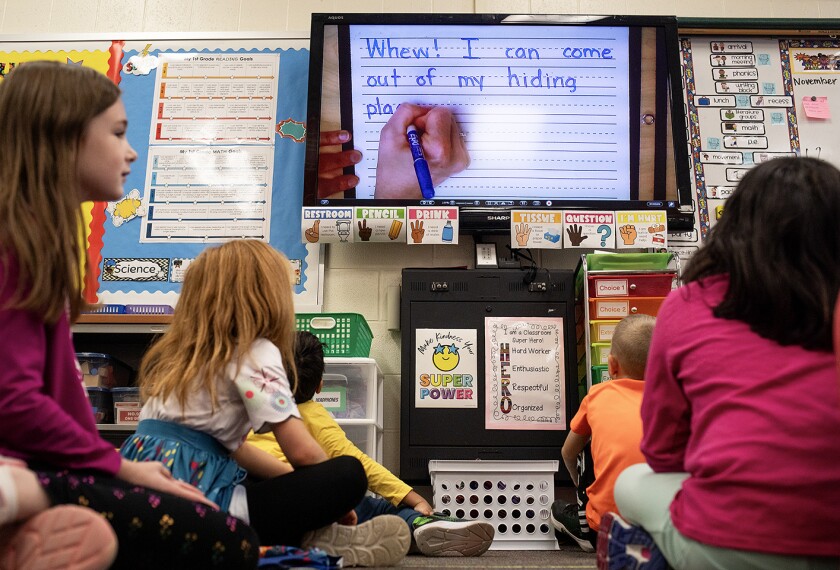Florida teenager Jessica M. Fox is “kind of anti-sports” and admits to having no interest in sweating alongside her peers in a high school gym class. So, while her classmates at Cypress Lake High School ran laps last year, the 16-year-old junior logged on to the Internet for a new kind of physical education.
Some 1,600 students statewide are expected to follow in her footsteps this year by enrolling in a cyberspace gym class to knock off the state’s high school graduation requirement of one semester of physical education.
“Personal Fitness” is not a video game. The half-credit course is one of the Florida Virtual School’s most popular offerings, and it actually requires some real-world exercise. How much and how hard students work out, however, is largely up to them.
Ms. Fox, whose 2,000-student high school is in Fort Myers, said she took the class with the Orlando-based online high school because it looked heavy on academics and light on exercise. “It takes more time than regular gym class because there are more assignments and reading and writing, but I’m better at that anyway,” she said. “I know my friends at school definitely had to do a lot more running.”
Florida Virtual School officials said the online fitness class is not an easy out for students who hope to clear high school without breaking a sweat.
“There’s nothing passive about online learning,” said Bruce B. Friend, the chief academic officer of the virtual school. “Most of our students tell us they’re doing more in our personal-fitness class than they would in their own schools.”
Some experts doubt that claim.
Judith C. Young, the executive director of the National Association of Sport and Physical Education, concedes that the Internet may be useful for teaching students about nutrition, the benefits of exercise, obesity, and other health concepts that round out a good gym class. But the technology has its limits, she argued.
“The cognitive aspect of this class is great, but the problem comes in with the performance part of physical education,” said Ms. Young, whose association is based in Reston, Va. “If this [online class] is the only experience some students are going to have with physical education, it’s questionable.”
Ms. Young said Florida is the only state she knows of where students have the option of receiving all of their physical education through the Internet.
Welcome to ‘Wellville’
The Florida Virtual School’s fitness class doesn’t look like a cakewalk.
Students must work their way through a virtual village called “Wellville,” which consists of 11 modules containing all the fitness and nutrition content the state wants students to know before graduation.
Those who enroll in the class have to complete a fitness pre- and post-test; pass nine quizzes and a final exam; memorize the meaning of terms like “hypothermia,” “heat cramp,” and “shin splint"; determine their body-mass index; and learn about the dangers of obesity, the benefits of stretching, healthy methods of weight loss, and daily calorie requirements.
Add to that work the actual exercise required, and teenagers should find themselves spending six to 10 hours a week on the class, said physical education instructor Jo D. Wagner.
But how reliable are the exercise logs the students submit as proof that they’re working out every week? The school’s physical education teachers never see their students. Instead, they rely on parents or other approved adults to keep the teenagers honest.
So students could say they ran a mile when they didn’t. Or they could claim they did 50 sit-ups when they barely managed half that number.
Ms. Wagner insisted that kind of fudging isn’t likely.
“The first thing I ask the parents is, ‘Have you seen ‘em sweat?’” said Ms. Wagner, who has taught physical education for 19 years. “We do monthly progress notes for our kids and their parents, and we require [teachers to make] at least one monthly telephone contact with students and parents.”
The online fitness course is hard enough, she said, that some students drop out rather than do the work required. But those teenagers are few and far between: The class had a 93 percent completion rate last year.
Suffering from both asthma and acid reflux, sophomore Chelsey M. Campbell said she wasn’t wild about exercise, but the online class got the home-schooled Palm City teenager to the community gym last semester.
She didn’t look forward to the workouts, but said she didn’t consider cheating an option.
“I went with my Mom every time, and I did what I said I would,” the 15-year-old said. “This was not my first course at this school, so I realized it absolutely does you no good to lie.”
Coverage of technology is supported in part by the William and Flora Hewlett Foundation.




